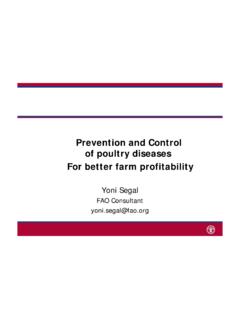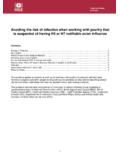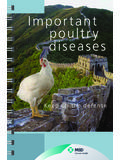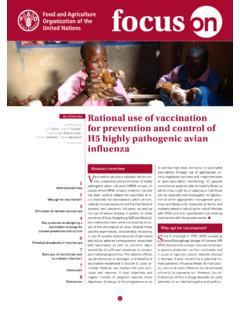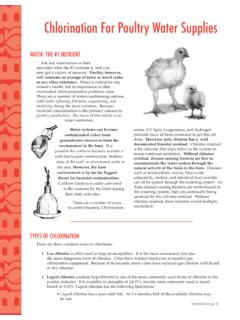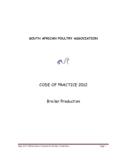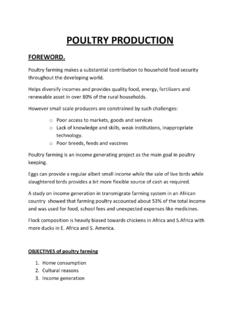Transcription of Infectious animal diseases: the wildlife/livestock interface
1 IntroductionIt is beyond the scope of this chapter to discuss in any depththe many important animal diseases that cross-infect domesticand wild animals. Certain of these diseases are coveredindividually in sufficient detail in other chapters of this objective of this chapter is to illustrate and discuss certainepidemiological concepts, observations and philosophiesrelated to diseases crossing the interface between livestock andfree-ranging wildlife , with emphasis on their detection,diagnosis and management. This interface may be linear, asalong a fence line, or patchy reflecting habitat preferences ofa disease host. It may also be focal at a shared water point, ordiffuse, where range and resources are shared such as the casewith the pastoral societies in the savannah ecosystems of Africa,and also in North America and the entire area of greater Europewhere abundant populations of wild cervids and suids occur inmany rural areas.
2 Wherever this interface occurs, it should beregarded as a two-way street with the potential for thetransmission of pathogens in either direction: from the wild todomestic animals, or from domestic animals to wildlife . Ingeneral, animal diseases which occur in any specific country orRev. sci. tech. Off. int. Epiz., 2002, 21 (1), 53-65 Infectious animal diseases: the wildlife / livestock interfaceSummaryThe long-standing conflict between livestock owners and animal healthauthorities on the one hand, and wildlife conservationists on the other, is largelybased on differing attitudes to controlling diseases of livestock which areassociated with wildlife . The authors have attempted to highlight the fact thatthese disease problems are frequently bi-directional at the wildlife /livestockinterface.
3 The different categories of diseases involved are presented. A newdimension being faced by veterinary regulatory authorities is the spectre ofemerging sylvatic foci of diseases, such as bovine tuberculosis, bovinebrucellosis and possibly rinderpest; these diseases threaten to underminenational and international eradication schemes, which have been implementedand executed with significant success, and at great cost. Conversely, wildlife -based ecotourism world-wide has expanded rapidly over the past decade and isthe source of lacking foreign revenue for many developing countries. Traditionalsubsistence farming is still the largest source of much-needed protein on somecontinents and this, together with the growth and hunger of historicallydisadvantaged communities for land, is forcing enterprises and communities withmarkedly different objectives and land-use practices to operate effectively inclose proximity.
4 Some land-users rely exclusively on wildlife , others on livestockand/or agronomy, while yet others need to combine these activities. The netresult may be an expansion or intensification of the interface between wildlifeand domestic livestock , which will require innovative control strategies thatpermit differing types of wildlife / livestock interaction, and that do not threaten theland-use options of neighbours, or the ability of a country to market animals andanimal products diseases Diagnosis Domestic animals Management Bengis(1), Kock(2)& J. Fischer(3)(1) Veterinary Investigation Centre, Kruger National Park, Box 12, Skukuza 1350, South Africa(2) Pan African Programme for the Control of Epizootics (PACE) Epidemiology, Organization of AfricanUnity/Inter-African Bureau for animal Resources (OAU/IBAR), Box 30786, Nairobi, Kenya(3) Southeastern Co-operative wildlife disease Study, College of Veterinary Medicine, University of Georgia,Athens, Georgia 30602-7393, United States of America OIE - 2002 OIE - 2002region, fall arbitrarily into one or more of three basic categories,namely.
5 Indigenous diseases, which are endemic to the country orregion and are generally maintained in the livestock herdsand/or free-ranging wildlife populations; this category alsoincludes certain multi-species diseases that have an almostworld-wide distribution, such as anthrax, rabies as well ascertain enteropathogenic and anaerobic bacterial diseases alien/exotic diseases which have been introduced into acountry or region, usually from the importation of infectedanimals or animal products emerging, re-emerging or truly novel health is an important issue for the agriculturalindustries as well as wildlife conservationists. Both groups haveconcerns as to what impact various diseases may have on theiranimals or populations, and each group is apprehensive aboutpossible disease introduction and transmission at the the contrasting perspectives of livestock -basedagriculture and wildlife conservationists on animal healthissues, it must be stressed that there is substantial commonground.
6 In much of sub-Saharan Africa, pastoralism hastraditionally provided a viable land use and a relativelysustainable livelihood. Pastoralists have shown a remarkabledegree of tolerance for wildlife with which they share thehabitat, this resulting in significant populations of wild animalsoutside of officially protected areas .In developed countries, many of the same people are involvedin both wildlife conservation and animal agriculture activities,and have an understanding of both sides of the controversialissues. Frequently, livestock are grazed on public land that isshared by wildlife . livestock agriculturists and wildlifemanagers understand the concept and value of populationhealth management as opposed to individual animal treatmentand the concern for foreign animal disease introduction ismutual.
7 In addition, both groups are competing against a tideof humanity as human populations increase the demand forland and water resources. There is also unified concernregarding certain radical animal rights movements directedagainst consumptive use of both wild and domestic , because the land base for much of wildlife production indeveloped countries is on private land, and much of privateland is used for animal agriculture, many farming enterprisesare indirectly beneficial to Tables I, II and III, the epizootic potential ( the potentialfor the specific disease to rapidly spread across vast expanses ofterritory, as well as international boundaries, causing large-scaledamage in livestock or wildlife populations over a short periodof time) is graded as major, moderate or limited.
8 This epizooticpotential is related to several epidemiological determinants,such as virulence and transmissibility of the causative organism,climatic and environmental factors, presence or absence ofmaintenance hosts, mode of transmission, presence or seasonalabundance of vectors, and presence of susceptible with major epizootic potential are generally the highlycontagious viral diseases ( foot and mouth disease [FMD],rinderpest, Newcastle disease , African swine fever and classicalswine fever), and these may have a significant impact ondomestic livestock populations, agricultural-based exporteconomies and wildlife . However, at the rural, subsistencefarming and pastoral levels of the developing world, it is mostfrequently the vector-borne diseases, such as trypanosomosis,cowdriosis and theileriosis, which only have moderate orlimited epizootic potential, that are the greatest diseaseobstacles to agricultural development and , sympatric wildlife are resistant to these diseases,and may even be silent carriers of (indigenous) diseasesTable I lists some of the more important diseases associatedwith wildlife that have been known to cause disease indomestic livestock .
9 The single most important factorresponsible for causing an outbreak of any one of these diseasesis probably the direct or indirect (vector) contact of infectedwild hosts or populations with susceptible domestic animals atthe interface of their ranges; where mixing has occurred oncommon rangeland, or where other resources (water) epidemiological determinants, transmission andmaintenance mechanisms have been studied in depth andare well understood for some of these diseases, as discussedbelow, while for others, such as cowdriosis, Rift Valley fever,lumpy skin disease , Newcastle disease and bluetongue, thereare still many unanswered epidemiological and mouth diseaseIn the case of FMD in Africa, the pivotal role played by theAfrican buffalo (Syncerus caffer) as a sylvatic maintenance hostwas identified in the late 1960s (18, 19)
10 And possiblemaintenance mechanisms of infection have been discussed (20,64). Outside Africa, FMD is maintained mainly in domesticruminants, particularly cattle, and wildlife occasionally becomeinfected incidentally by spill over .African swine feverWith regard to African swine fever, the elegant studies byPlowright and co-workers (46, 47, 48) elucidated themaintenance host role of argasid ticks (Ornithodorus moubata),and the secondary role played by free-ranging wild porcines hasalso been described (49, 63).54 Rev. sci. tech. Off. int. Epiz.,21 (1) OIE - 2002 Rev. sci. tech. Off. int. Epiz.,21 (1)55 Alcelaphine herpesvirus-1 Similarly, the important role played by wildebeest (Connochaetestaurinus) in the maintenance and seasonal shedding ofAlcelaphine herpesvirus-1 has been elucidated (37, 44, 45, 52).










